[/caption]
The first ever Vesta Vista snapped from the protoplanets orbit has been transmitted back through 117 million miles of space to eager eyes waiting on Earth. Although Vesta had been observed by telescopes on Earth and in space for more than two centuries since its discovery, only scant detail on its surface could be discerned until today.
NASA’s Dawn spacecraft took the new photo of the giant asteroid Vesta on July 17 – enhanced version shown above – less than 2 days after making space history as the first probe ever to enter orbit about an object in the main Asteroid Belt. The team also released their first 3 D image of Vesta. Read my orbital capture story here and see the original NASA image below.
“I think it is truly thrilling to be turning what was little more than a fuzzy blob for two centuries into a fascinating alien world,” said Dawn Chief Engineer Marc Rayman in a new post orbit interview with Universe Today.
Vesta is 330 miles (530 kilometers) in diameter and the second most massive object in the Asteroid Belt between Mars and Jupiter.
“And the closer Dawn gets to Vesta, the more exotic and intriguing the pictures become !,” added Rayman.
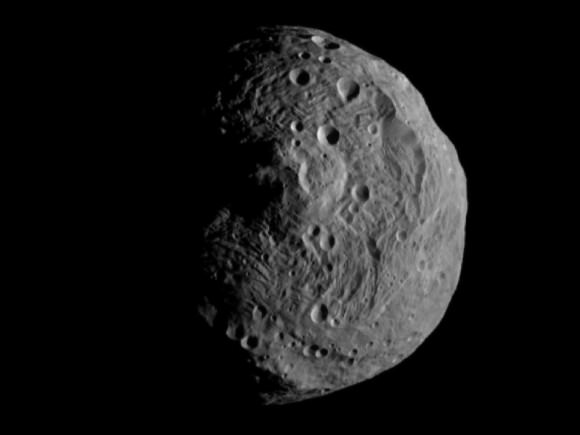
NASA's Dawn spacecraft obtained this image with its framing camera on July 17, 2011. It was taken from a distance of about 9,500 miles (15,000 kilometers) away from the protoplanet Vesta. Each pixel in the image corresponds to roughly 0.88 miles (1.4 kilometers). Credit: NASA/JPL-Caltech/UCLA/MPS/DLR/IDA
Enhanced image above
Dawn was captured into orbit at an altitude of 9,900 miles (16,000 km) at 1 a.m. EDT on July 16 according to Rayman, of the Jet Propulsion Lab in Pasadena, Calif. and is now slowly descending over the next few weeks.
“The spacecraft remains healthy, and our spiral down to Vesta is going well,” Rayman told me.
The new photo from orbit is nearly centered on the south pole which suffered a devastation cosmic collision eons ago. That blast sent huge plumes of ejecta streaming out, including towards Earth. About 5% of all known meteorites stem from Vesta.
“The south pole is a bulging feature in the images,” said Prof. Chris Russll, Dawn’s Science Principal Investigator of UCLA in an interview.
“The pole is not centered on this feature but is close to it. We have not finalized our determination of the pole but are close to a ‘final’ answer. We are not making interpretations at this point because the greater resolution that is coming will make all today’s speculations moot,” Russell stated.
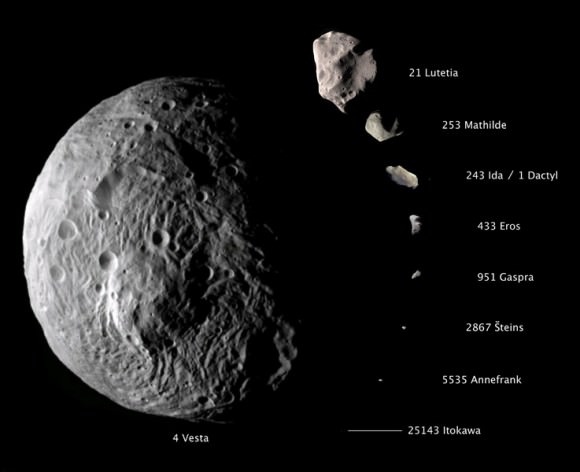
This composite image shows the comparative sizes of nine asteroids visited by Earthly spaceships. Up until now, Lutetia, with a diameter of 81 miles (130 kilometers), was the largest asteroid visited by a spacecraft, which occurred during a flyby. Vesta, which is also considered a protoplanet because it's a large body that almost became a planet, dwarfs all other small bodies in this image, with its diameter sizing up at approximately 330 miles (530 kilometers). Credit: NASA/JPL-Caltech/JAXA/ESA
By early August, Dawn will have gently been nudged into its initial science observation orbit at an altitude of approximately 1700 miles above the scarred surface of newly discovered mountains, craters, grooves, scarps and more.
During the approach phase, the Dawn team will accomplish multiple tasks with its onboard systems and three science instruments; including the search for possible moons, observing Vesta’s physical properties and obtaining calibration data.
But don’t expect a continuous stream of new pictures, according to Russell.
“We will not have a steady stream of images until we are in one of our
three science phases,” Russell told me. “When we are in transit from one place to another we thrust, stop, turn, image, turn, transmit, turn, thrust, and several days later repeat. All time spent not thrusting is time taken away from science later.”
“The next image is scheduled to be snapped on Saturday July 23.”
We will learn a lot more at the next press conference scheduled to take place on Monday August 1 from JPL.
Dawn will spend one year orbiting around Vesta and collecting high resolution mapping images, determining the chemical composition and measuring its gravity field. Then it will fire its ion thrusters to propel the probe to a second destination, the dwarf planet Ceres, arriving in February 2015.
The Asteroid Belt is one of the last unexplored regions of our solar system.
“We are beginning the study of arguably the oldest extant primordial surface in the solar system,” elaborated Russell in a NASA statement. “This region of space has been ignored for far too long. So far, the images received to date reveal a complex surface that seems to have preserved some of the earliest events in Vesta’s history, as well as logging the onslaught that Vesta has suffered in the intervening eons.”
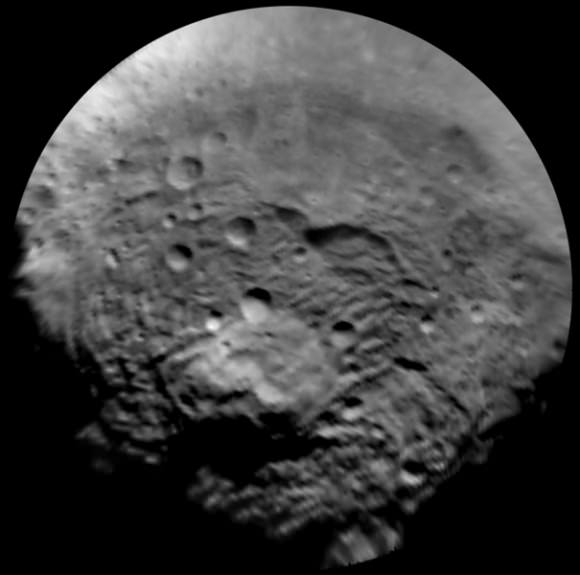
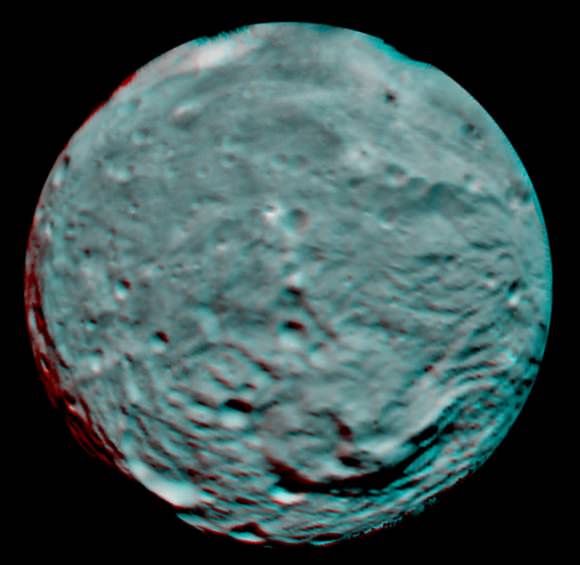
This anaglyph image of the south polar region of the asteroid Vesta was put together from two clear filter images, taken on July 9, 2011 by the framing camera instrument aboard NASA's Dawn spacecraft. Each pixel in this image corresponds to roughly 2.2 miles (3.5 kilometers). The anaglyph image shows the rough topography in the south polar area, the large mountain, impact craters, grooves, and steep scarps in three dimensions. The diameter of Vesta is about 330 miles (530 kilometers). Use red-green (or red-blue) glasses to view in 3-D. NASA/JPL-Caltech/UCLA/MPS/DLR/IDA
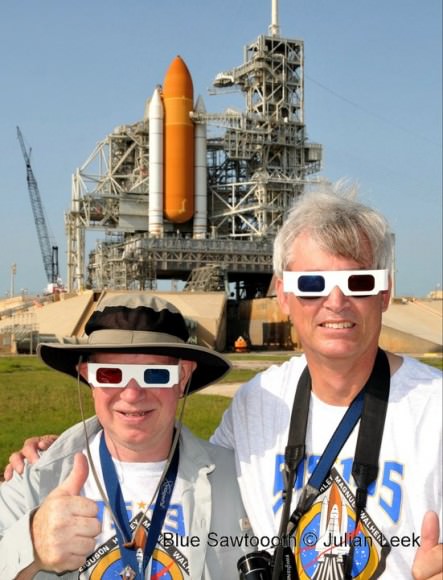
STS-135 twins show the right and wrong way to wear nifty 3-D glasses. Remember; red on the left (Ken Kremer – at right & Mike Barrett – at left, wrong) – backdropped by Space Shuttle Atlantis at the base of Launch Pad 39A at the Kennedy Space Center. Credit: Julian Leek
Read my prior features about Dawn
Dawn Exceeds Wildest Expectations as First Ever Spacecraft to Orbit a Protoplanet – Vesta
Dawn Closing in on Asteroid Vesta as Views Exceed Hubble
Dawn Begins Approach to Asteroid Vesta and Snaps First Images
Revolutionary Dawn Closing in on Asteroid Vesta with Opened Eyes

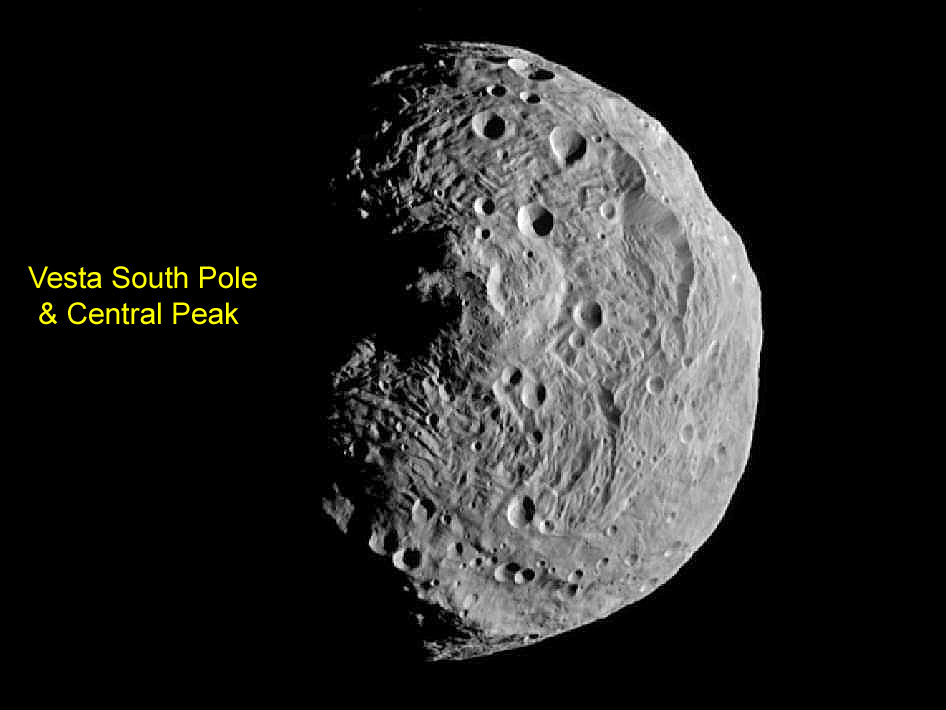
Someone suggested a lander on the last Vesta post…
Dawn’s ion drive gives an acceleration of about 0.001g. Vesta’s gravity at the surface is about 0.022g. So Dawn’s ion drive is about 20 times too small for a lander. It would be nice to have a craft that could cruise around the asteroid belt, landing where it pleases, but this is a tall order for ion drives.
Vesta’s escape velocity is about 350 m/s. You don’t need to achieve escape velocity to escape Vesta, because the drive will be running, but it is a measure of the sort of velocities you will need, and that is a lot more then you could easily get by pushing against Vesta, with a winch launch.
You could use a space elevator, though. Vesta rotates in a bit over 5 hours, so geostationary orbit is about 520 km above the planet’s centre, or about 255 km above the surface. If you used the rest of the craft as the counterweight, you muight need 300 km of fibre. This sounds mad, but if 5000 km of buckytubes can support themselves under earth’s gravity, the 300km of fibre to land on Vesta need weigh only a tiny fraction of the lander.
If Vesta was not rotating as fast, you might still be able to land for an hour or two and take off again, if the lander swung on the cable to match the speed of the surface. The cable might have to be stronger, but not by much. I had originally wondered about getting a soft touchdown by matching a swing to a descent for Curiosity. The top end of the rope would then be a parachute, and you would start climbing up the rope as the ground came up to soften the landing.
I expect this is all very silly, but having done some of the sums, I thought I’d share.
Someone suggested a lander on the last Vesta post…
Dawn’s ion drive gives an acceleration of about 0.001g. Vesta’s gravity at the surface is about 0.022g. So Dawn’s ion drive is about 20 times too small for a lander. It would be nice to have a craft that could cruise around the asteroid belt, landing where it pleases, but this is a tall order for ion drives.
Vesta’s escape velocity is about 350 m/s. You don’t need to achieve escape velocity to escape Vesta, because the drive will be running, but it is a measure of the sort of velocities you will need, and that is a lot more then you could easily get by pushing against Vesta, with a winch launch.
You could use a space elevator, though. Vesta rotates in a bit over 5 hours, so geostationary orbit is about 520 km above the planet’s centre, or about 255 km above the surface. If you used the rest of the craft as the counterweight, you muight need 300 km of fibre. This sounds mad, but if 5000 km of buckytubes can support themselves under earth’s gravity, the 300km of fibre to land on Vesta need weigh only a tiny fraction of the lander.
If Vesta was not rotating as fast, you might still be able to land for an hour or two and take off again, if the lander swung on the cable to match the speed of the surface. The cable might have to be stronger, but not by much. I had originally wondered about getting a soft touchdown by matching a swing to a descent for Curiosity. The top end of the rope would then be a parachute, and you would start climbing up the rope as the ground came up to soften the landing.
I expect this is all very silly, but having done some of the sums, I thought I’d share.
It’s true that Dawn wouldn’t be capable of making a touchdown but the original suggestion was for a dedicated lander to be sent with the equipment for pulling it off (which would most probably involve conventional thrusters).
Anyway, I’m intruiged by the idea of winching a craft down to the surface. Without a diagram I’m not certain I get what you mean – are you suggesting lowering a lander down on a cable, while the main craft (at the other end of the cable) climbs into a higher orbit to keep the centre of mass of the whole thing at geostationary orbit? I’d love to see the physics and engineering of that explored, just as a hypothetical, but I think conventional thrusters will always be the superior option.
Yep, your description is pretty good. There have been quite a few missions with two bodies connected by string. See for example http://en.wikipedia.org/wiki/Space_tether_missions The one I particularly remember was the TSS-1R mission in 1996, where the cable got fried by the power it was to generate from the ionosphere. This might give all sorts of risks near the gas giants, but should be OK in the asteroid belt.
If the main craft generates solar power, then running the winch to raise the lander should be free. This is even better at conserving mass than an ion engine for that particular journey.
Good point! It would be an entirely fuel-less solution. The main craft wouldn’t even need to thrust into higher orbits because the conservation of momentum would ensure it ascends as the lander descends anyway.
I’m not sure mass loss would present any more challenge to the mission than engineering a winch mechanism though (not to mention the software to operate it).
One problem that comes to mind is: how would you keep the cable taught?
The cable would be kept taught by tidal forces. Not only that, it would automatically be held perpendicular to the surface.
It’s certainly an interesting idea, but as a practical application I think that NASA or JPL engineers are generally opposed to solutions that involve reeling things back in: there are just too many things that can go wrong with that process. So you could land something but you couldn’t pull it back, which would be the real advantage of this system given the minimal fuel needed for a landing.
The ion drive may only deliver 0.09 N, but I read the hydrazine reaction control system gives 0.9 N on each thruster.
Someone suggested a lander on the last Vesta post…
Dawn’s ion drive gives an acceleration of about 0.001g. Vesta’s gravity at the surface is about 0.022g. So Dawn’s ion drive is about 20 times too small for a lander. It would be nice to have a craft that could cruise around the asteroid belt, landing where it pleases, but this is a tall order for ion drives.
Vesta’s escape velocity is about 350 m/s. You don’t need to achieve escape velocity to escape Vesta, because the drive will be running, but it is a measure of the sort of velocities you will need, and that is a lot more then you could easily get by pushing against Vesta, with a winch launch.
You could use a space elevator, though. Vesta rotates in a bit over 5 hours, so geostationary orbit is about 520 km above the planet’s centre, or about 255 km above the surface. If you used the rest of the craft as the counterweight, you muight need 300 km of fibre. This sounds mad, but if 5000 km of buckytubes can support themselves under earth’s gravity, the 300km of fibre to land on Vesta need weigh only a tiny fraction of the lander.
If Vesta was not rotating as fast, you might still be able to land for an hour or two and take off again, if the lander swung on the cable to match the speed of the surface. The cable might have to be stronger, but not by much. I had originally wondered about getting a soft touchdown by matching a swing to a descent for Curiosity. The top end of the rope would then be a parachute, and you would start climbing up the rope as the ground came up to soften the landing.
I expect this is all very silly, but having done some of the sums, I thought I’d share.
Someone suggested a lander on the last Vesta post…
Dawn’s ion drive gives an acceleration of about 0.001g. Vesta’s gravity at the surface is about 0.022g. So Dawn’s ion drive is about 20 times too small for a lander. It would be nice to have a craft that could cruise around the asteroid belt, landing where it pleases, but this is a tall order for ion drives.
Vesta’s escape velocity is about 350 m/s. You don’t need to achieve escape velocity to escape Vesta, because the drive will be running, but it is a measure of the sort of velocities you will need, and that is a lot more then you could easily get by pushing against Vesta, with a winch launch.
You could use a space elevator, though. Vesta rotates in a bit over 5 hours, so geostationary orbit is about 520 km above the planet’s centre, or about 255 km above the surface. If you used the rest of the craft as the counterweight, you muight need 300 km of fibre. This sounds mad, but if 5000 km of buckytubes can support themselves under earth’s gravity, the 300km of fibre to land on Vesta need weigh only a tiny fraction of the lander.
If Vesta was not rotating as fast, you might still be able to land for an hour or two and take off again, if the lander swung on the cable to match the speed of the surface. The cable might have to be stronger, but not by much. I had originally wondered about getting a soft touchdown by matching a swing to a descent for Curiosity. The top end of the rope would then be a parachute, and you would start climbing up the rope as the ground came up to soften the landing.
I expect this is all very silly, but having done some of the sums, I thought I’d share.
Amazing article. I look forward to manned missions like these. http://www.iampleasant.com/
Do you really mean that or are you just promoting your website?
Is that really so awful? Perhaps he’s doing both…looking forward to manned missions AND promoting his blog. No need to be so morose about it. Scientific discussion can’t hurt, even if it’s wrongheaded…which his isn’t.
In that case, what is there to stop the “Electric Universe” brigade from doing the same?